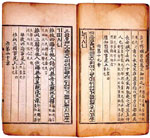
Yongbieocheonga: The work eulogizes the virtue of the ancestors for the House of Yi, the founding family of the Joseon Dynasty, likening them to a deep rooted tree and a spring of deep waters
Korean literature is usually divided chronologically into classical and modern periods. Korea's classical literature developed against the backdrop of traditional folk beliefs. It was also influenced by Taoism, Confucianism, and Buddhism. Among these, Buddhist influence held the greatest sway, followed by enormous influences from Confucianism during the Joseon period.
Modern literature in Korea, on the other hand, developed out of its contact with Western culture, following the course of modernization. Not only Christian thought, but also various artistic trends and influences were imported from the West. As the “New Education” and the “National Language and Literature Movement” developed, the Chinese writing system, which had traditionally represented the culture of the dominant class, lost the socio-cultural function it had previously enjoyed.
The hyangga poetry of the Silla period signaled the beginning of a unique poetic form in Korean literature. The hyangga were recorded in the hyangchal script the in which the Korean language was written using, “sound” (eum) and “meaning” (hun) of Chinese characters. Fourteen poems in the hyangga style from the Silla period have been preserved in the Samgungnyusa (Memorabilia of the Three Kingdoms).
The literature of the Goryeo period is marked by an increased use of Chinese letters, the disappearance of hyangga, and the emergence of Goryeogayo (Goryeo songs) which continued to be transmitted as oral literature until the Joseon period.
The creation of Hangeul in the early Joseon period was a key turning point in the history of Korean literature. Akjang (musical scores) were written in the Korean script, such as Yongbieocheonga (Songs of Flying Dragons Through the Heavens).
The sijo (current tune) is representative of Joseon period poetry. Its poetic form was established in the late Goryeo period, but it flourished to a greater extent under the Joseon period's new leading ideology, the Neo-Confucianism of China's Song Dynasty. Another form of Joseon-period poetry, the gasa is properly placed in the category of verse, but its content is not limited to the expression of individual sentiment. It often includes moral admonitions.
![Honggildongjeon [The Story of Hong Gil-dong, the first novel published in Hangeul] is a work of social criticism that scathingly attacked the inequities of Yi society with its discriminatory treatment of illegitimate offspring and its differences based on wealth](http://www.korea.net/cheditor40_asp/cheditor/attach/200852910151180991.jpg)
Honggildongjeon [The Story of Hong Gil-dong, the first novel published in Hangeul] is a work of social criticism that scathingly attacked the inequities of Yi society with its discriminatory treatment of illegitimate offspring and its differences based on wealth
The first classical fictions in Korea include Kim Si-seup's Geumosinhwa (Tales of Geumo) which was written in Chinese characters and Heo Gyun's Honggildongjeon (Tales of Hong Gil-dong) written in Hangeul.
As time passed, Hangeul was used widely in Korean society, resulting in the growth and development of Korean language and literature studies.
Modern Korean literature was formed against the background of the crumbling feudalistic society of the Joseon Dynasty and the importation of new ideas from the West.
As forms of modern Korean literature, the changga (new type of song) and sinchesi (new poetry) were hailed as new poetic forms.